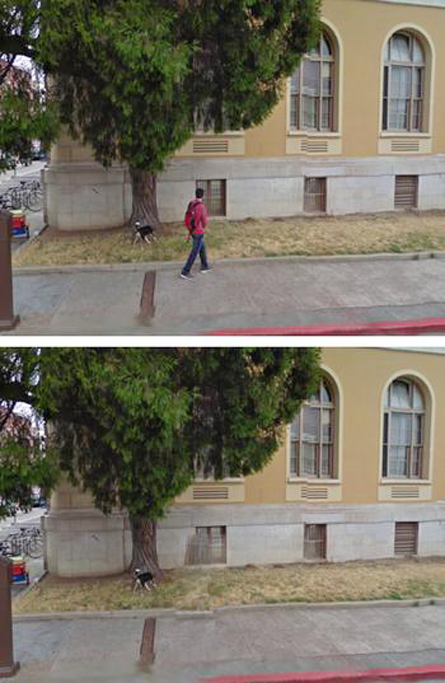Protecting innocent — and not so innocent — bystanders
Technique removes pedestrians from Google Street View images
- More than 2 years ago
Google’s all-seeing eye gives some people the willies. The technology megalith’s Street View provides panoramic spreads of city streets, allowing users to stroll virtually in places they have never been. Apartment hunters can peek at houses from real estate listings. The directionally challenged can look for landmarks on the way to their destinations. But Street View shows much more than what’s there. It also reveals who was in a neighborhood, and whatever they were up to, at the moment the car-mounted Google camera whizzed past.
Concerns have already been raised that Street View is a digital Peeping Tom. The company’s plans to add Germany’s 10 largest cities to Street View by the end of 2010 was met with such a hue and cry that Google announced this week that Germans could opt out of having their homes visible on the service.
License plates and faces are already blurred on Street View. But a computer science graduate student at the University of California, San Diego has come up with what he thinks is a better idea: Remove the pedestrians all together. Arturo Flores originally considered designing a program to remove objects such as street lamps or trees from Street View so users could see an obscured building full frontal. But given the privacy brouhaha, Flores decided to tackle people.
Flores started with an existing pedestrian-detecting algorithm and combined it with a new algorithm of his own creation that removes the person from the scene. Since Street View captures images from many angles, his algorithm simply grabs pixels from shots taken before and after the image showing the pedestrian. These pixels can then be used to fill in the background where the person has been removed.
“It still needs some work before it’s released into the wild,” says Flores. For example, crowds of people are problematic, as are backgrounds that don’t have a flat building framing the person.
No word yet on whether Goggle will take advantage of the program, says Flores’ professor, UCSD computer scientist Serge Belongie. But Google certainly has the manpower and the talent to run with the idea, he says. “The project is a nice combination of computer science and social awareness,” he says. “All too often, computer scientists implement something just because it is cool rather than there being a need.”








